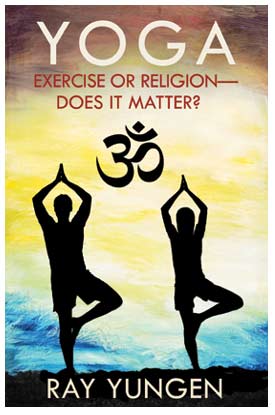Note: The following is from Ray Yungen’s updated booklet on Yoga. Today, countless numbers of Christians (and the churches they attend) are incorporating Yoga exercises into their lives, thinking that “just doing the exercises” is OK. If you know someone who is doing Yoga (even “just the exercises”), please give them a copy of this article or the booklet.
By Ray Yungen
It is a moment that troubles me even now. Once, when I was giving a presentation at a Christian college about New Age spirituality, I noticed a student roll her eyes when I mentioned the term, Yoga. It was a small gesture, yet it spoke volumes—as if to say, “Give me a break! It’s just exercises!” I surmised from her response that she was a Yoga practitioner or had at least been exposed to the subject and believed that participation in Yoga had no negative impact on one’s spiritual life. After all, the young lady was attending a Christian college, so she likely presumed she was discerning enough to know whether a practice was pagan or not. But she gave no biblical evaluation of Yoga, and rather wordlessly defended it. Unfortunately, this trend to accept Yoga and other New Age practices has only continued to accelerate within Christian colleges, ministries, and even churches.
Just Exercise?
Currently, an estimated 24 million people (as of 2022, that number has increased to nearly 40 million) in the United States are regularly involved with some form of Yoga.1 In the town where I live, the high majority of health clubs, including the YMCA, YWCA, and the local community college, offer Yoga classes. According to a survey by the National Institute of Health (NIH) and the Centers for Disease and Prevention, nearly ten percent of U.S. adults and three percent of children participated in yoga in 2012.”2 (According to new surveys, those numbers have increased dramatically by 2022 (https://geekhealthjournal.com/yoga-statistics/).) Most of these adults may be vaguely aware of the Hindu component of Yoga but see that as being irrelevant to taking Yoga classes. Many people doing the asanas, or postures, seem to feel that these exercises are devoid of any religious connotation.
Professor Bradley J. Malkovsky of Notre Dame University makes the following observation, which aptly demonstrates how Yoga has gone from being relatively obscure to notably pervasive:
I remember almost twenty years ago how the first time I mentioned the word yoga in one of my theology classes, many of my students, most of whom were Christian, could not stifle their laughter. They thought the whole idea of practicing yoga was strange and exotic, something that people of other religions did. Only one student out of about seventy that day had ever tried yoga. But nowadays almost every hand goes up when I ask which students have practiced yoga. Things have clearly changed. Yoga is more prevalent now than ever among people living in the West.3
Professor Malkovsky goes on to say Yoga’s popularity is not just linked to physical fitness primarily, but is an age-old system with a definite spiritual component:
If my students end up going deeper into yoga than simply practicing āsanas [postures], they will learn just how much the wisdom of ancient India can spiritually nourish them, even here on the other side of the world, in twenty-first-century America.4
I find it interesting (but also disconcerting) that many people really don’t examine the reality behind this last statement. To many Americans, Yoga is only exercise, although of a more exotic variety. Generally, people think the different postures aid in healing and strengthening the physical body. Some may also maintain that Yoga calms the mind as well, but from years of research, I have determined only relatively few are aware that Yoga is a religious practice. Can I prove this? Consider the following. If you go to the Fitness” section of any bookstore and look in the Yoga subsection, you will find references to the spiritual aspects of Yoga such as the chakra system, kundalini, etc. in almost every book on Yoga. It is quite rare to find a book on Yoga that does not incorporate spiritual concepts found in classic Hinduism. To devout Hindus, Yoga cannot be separated into physical and spiritual parts. Both are relevant to the practice, with the end desire being a profound religious experience.
The word “yoga” actually means to be yoked to or united in body, mind, and spirit with Brahman (the Hindu concept of God).5 It doesn’t get more spiritually obvious than that.
Yoga adherents cannot divorce the religious or spiritual aspects of Yoga from the physical because the physical postures were, from their inception, specifically designed to serve as conduits to yogic religious experience. In fact, it cannot really be called Yoga without union with the spiritual realm. Yoga is union with Brahman, the Hindu view of God. If you are not on the road to being connected with Brahman, you can’t really call it Yoga.
The Reality Behind Yoga
Beth Shaw, the founder and CEO of YogaFit (an organization which has trained over 250,000 instructors worldwide as of 2022), teaches that Yoga consists of far more than mere physical exercises. In her book, she reveals:
The ancient practice of meditation is as integral to yoga as the poses are, and they have the same intention: not to tune out, but to tune in to a frequency that is long forgotten or perhaps undiscovered.6 (emphasis added)
What exactly is this frequency she is talking about? Yoga instructor and author Stephen Cope provides the answer. He says, “We are all born divine. . . . This is the classic statement of the perennial philosophy of yoga.”7 This leaves little to the imagination when it comes to understanding the spiritual framework regarding the practice of Yoga. Cope has made his Yoga stance even clearer with the following two statements:
What we are seeking is already at the core of our nature. . . . We are already inherently perfect.8
It means that God is available to us fully in each moment, simply because God is our true nature.9
Yoga has been a springboard into the New Age for quite a number of people. One of them, Jack Canfield (bestselling author of the Chicken Soup books), attests to getting his spiritual jumpstart doing Yoga. In college, he took a Yoga class as an elective, did meditation, and became a believer. He said he “felt god flowing through all things.”10 In Canfield’s book The Success Principles, he writes:
As you meditate and become more spiritually attuned, you can better discern and recognize the sound of your higher self.11
This is basically Yoga 101.
Occultist and “prophetess” Alice Bailey also reflected on this same definition. Bailey recognized that Yoga was something integral to the spread of New Age spirituality. Her reflection on it shows the emphasis the religion of occultism places on the practice of Yoga. You can see this when she proposed the following:
The Yogi, or the one who has achieved union (for Yoga is the science of union) knows himself as he is in reality . . . he knows himself to be, past all controversy, God.12 (parenthesis in original)
Even Aleister Crowley, the 20th century’s foremost proponent of occultism, saw Yoga as vital to his spiritual life. He offered his opinions and observations in his book Eight Lectures on Yoga. This body of work has been referred to as “the most scientific and informational work on Yoga ever written.”13
Exercising Biblical Discernment
It cannot be overstated that discernment, and an appropriate response to what is discerned, is one of the hallmarks of a mature Christian. We live in an age where the acceptance of trendy practices, such as Yoga, is hammered into us from every side, with the end result being an ecumenical generic inter-spirituality that fits everybody.
Believers in Christ have fallen prey to some dangerous ideas. One is that we feel free to draw from pagan sources. Or, as is popularly stated, we can chew the meat and spit out the bones. But this doesn’t make any sense from a biblical standpoint. As a Christian, we can’t segregate into portions what part we think will do us harm and what part will profit us. If the foundational spirituality is contrary to God’s Word, then it will be folly to interact with it.
Another saying that is often used as a defense is the old phrase, “Don’t throw the baby out with the bathwater.” But as the late apologist Dave Hunt used to say, what if it’s Rosemary’s Baby?14 (a horror movie from the 1960s).
One of the reasons that Yoga has become so popular is that it lacks many of the sexual taboos that the Judeo/Christian tradition has. In other words, the reason Yoga is compatible with people such as Aleister Crowley, who was considered one of the most wicked men to ever live, is because Yoga overlooks the perversity of fallen human nature. The following account provides us with compelling food for thought—
Actress and sister/daughter to the singing Judds, Ashley Judd wrote a book about her social activism regarding the AIDS epidemic around the world. Accompanying her on trips was her close friend and celebrity Yoga instructor, Seane Corn. Judd told the following story to emphasize a spiritual point to her readers:
Back in the 1980s, Corn had worked as a bartender in a gay nightclub. One of the patrons of the club who was a close friend of Corn’s died of AIDS. Judd explained how before he died he passed on to Corn that God was in every person she met, even patrons of a gay bar. “Ignore the story [the lifestyle] and see the soul,” he told her. Corn said it was her “first lesson in the central tenet of Yoga—that we are all one.”15
What I find especially problematic is that at the beginning of her book, Ashley Judd describes herself as an evangelical Christian. An evangelical Christian is not supposed to believe the philosophy Judd has just related.
Know ye not that the unrighteous shall not inherit the kingdom of God? Be not deceived: neither fornicators, nor idolaters, nor adulterers, nor effeminate, nor abusers of themselves with mankind, nor thieves, nor covetous, nor drunkards, nor revilers, nor extortioners, shall inherit the kingdom of God. And such were some of you: but ye are washed, but ye are sanctified, but ye are justified in the name of the Lord Jesus, and by the Spirit of our God. (1 Corinthians 6: 9-11)
Am I saying that everyone who does Yoga is basically immoral? Not at all. But could it be that at least part of the reason homosexuality has become so accepted over the last thirty years, even now within parts of mainstream Christianity, is due to the widespread influence of Yoga and other mystically based practices? That’s certainly something to consider.
As believers, we are told in Romans 12:2, “And be not conformed to this world: but be ye transformed by the renewing of your mind, that ye may prove what is that good, and acceptable, and perfect, will of God.” We are often like the Old Testament Israelites whom the Lord commanded to “learn not the way of the heathen” (Jeremiah 10:2), and who were forbidden to marry pagan women (Jeremiah 16), and instead were enamored with the women of the nations surrounding them, and were thus seduced into idolatry.
When Yoga is viewed through the lens of the Cross of Christ, it is clear that the two are incompatible. When a person becomes involved with Yoga, he enters a realm of often subtle but powerful spiritual deception.
Unexpected Results
The Russel Simmons story is of special interest with regard to my warning about Yoga. Simmons was a young, street-wise black youth who later did quite well for himself as a hip-hop (rap) music producer. Ironically, Simmons did not fit any New Age stereotype, but a friend, as he put it, “dragged [him]into a yoga class,” and he “realized [he] had stumbled onto something incredible.”16 As a result, Simmons acquired the spiritual perspective that always accompanies the practice of Yoga. Simmons relates:
A lot of the time it seems like people are more comfortable listening to the God that is outside them, but I believe that God is already inside of you. . . . The God that’s in all of our hearts.17
The student I referred to in the beginning of this booklet who rolled her eyes when I mentioned Yoga might have reconsidered her response if presented with the facts you have just read in this article. This is exactly the point I am trying to make, that Yoga produces a certain perception. That perception is identical with what is commonly called New Age spirituality. Incidentally, Simmons has become a major Yoga “evangelist” and has written three books (one a best seller), which specifically target the young hip-hop audience.
Christine Aguilera, popular singer in the vein of Brittney Spears, fits right into this pattern. In a 2015 ABC news article titled “Yoga Serving As Inspiration For Aguilera’s New Music,” Aguilera states:
. . . taking a love for Yoga and breathing . . . not looking at it as an exercise, but just feeling more in one with the Earth and everyone being connected. It’ll definitely have a reflection on the new record.18
Aguilera is an influence to millions of young girls, who see her as a role model and emulate her. Aguilera is not an anomaly.
In the Western world, Yoga has become largely a female-based phenomenon; however, a growing number of men are doing Yoga now as well (between 2012 to 2016, men practicing Yoga in the US increased by 4 Million.) A high percentage of these men and women, such as Simmons, have gone on to become Yoga “missionaries,” with an interest in converting family members, friends, coworkers, etc. Such proselytizing has resulted in tens of millions around the world who have practiced Yoga. Just think about this: if each one of these people is able to influence just five or six people in their lifetime with regard to Yoga, we’d be looking at well over a quarter billion people.
It cannot be ignored that even if a person has no interest in the spiritual roots of Yoga, by taking a Yoga class or even participating via video or books, he or she is exposing him or herself to Hindu spirituality, which is inherent in the practice. People need to understand that Yoga is a religious expression and therefore cannot be compartmentalized (i.e., exercise vs. religion). Even the traditional Hindu greeting, Namasté, that is said at the end of Yoga classes, is spiritual. When translated, it means, “The god in me bows down to (or salutes) the god in you.” In essence, Namasté encompasses the full spectrum of the spirituality of the Age of Aquarius.
It is essential for us as Christians to comprehend the gravity of this situation and understand what Dr. Malkovsky is bringing to our attention. Most likely, you have someone in your circle of family and friends who has been involved with Yoga. My publisher, Lighthouse Trails, told me that they frequently receive phone calls from people telling them that their churches are doing Yoga and often at the prompting and leading of the pastors’ wives or women’s ministry leaders. What was once nearly unheard of within evangelical churches is now being increasingly accepted. In Dr. Malkovsky’s book, he proceeds to back up the very thing I am attempting to convey in this article:
[M]any people who are at first uninterested in meditation when they take up yoga practice gradually come to discover its value, especially if they have a teacher who understands that yoga’s ultimate aim is spiritual health, not merely physical health.19
Surprisingly, some advocates of Yoga do see the inherent clash between Yoga and Christianity. Stephanie Syman, in her book titled The Subtle Body: The Story of Yoga in America actually draws the same conclusions I am presenting. Her observation is that despite the promises of the Yoga community that Yoga “doesn’t [contradict] our most sacred beliefs,”20 it may very well do so. She explains:
[Yoga Proponents] may actually be wrong on this point. It’s hard to reconcile the subtle body [the chakras] and the possibility of experiencing divinity for yourself by methodically following a program of exercise, breathing, and meditation with Judeo-Christian notions of God and the afterlife, but we seem willing to ignore the discontinuities.21 (emphasis added)
Yoga has become so accepted and ingrained in the Western world that you can now find it everywhere, and I do mean everywhere! Recently, I was passing through a very small town in western Montana and was surprised to see a Yoga studio located in the center of town. What really got my attention was that this studio was named after the Hindu goddess, Shakti!
The Yoga boom, which began in the 1990s, has changed the very social fabric of our society in a way that will last well into the future. People need to be aware that Yoga serves spiritual ends and also need to realize just what the nature of that spirituality entails. Yoga is the religion of namasté (i.e., man is God). The fact is, there is no need for the Cross of Jesus Christ in Yoga. To the contrary, Scripture tells us:
. . . that in the ages to come he might shew the exceeding riches of his grace in his kindness toward us through Christ Jesus.(Ephesians 2:7; emphasis added)
To order copies of YOGA: Exercise or Religion—Does it Matter? in booklet format, click here.
Endnotes:
1. Kim Painter, “Ancient Practice of Yoga Now a Growth Industry (USA Today, March 3, 2015; http://www.usatoday.com/story/news/nation/2015/03/01/yoga-health-fitness-trends/23881391/).
2. Ibid.; information taken from the survey at https://nccih.nih.gov/research/statistics/NHIS/2012/mind-body/yoga.
3. Bradley Malkovsky, God’s Other Children: Personal Encounters with Love, Holiness, and Faith in Sacred India (HarperCollins, Kindle Edition), p. 152.
4. Ibid.
5. For example: http://www.universalspirityoga.com/whatisyoga.html.
6. Beth Shaw, Yoga Fit (Champaign, IL: Human Kinetics, 2015, 3rd Edition), p. 315.
7. Stephen Cope, Yoga and the Quest for the True Self (New York, NY: Bantam Books, 1999 edition).
8. Ibid.
9. Ibid.
10. Jack Canfield, Mark Victor Hansen, Dare to Win (New York, NY: Berkeley Books, 1994), p. 195.
11. Jack Canfield, The Success Principles (New York, NY: HarperCollins, 2015, 10th anniversary edition), p. 377.
12. Alice Bailey, From Intellect to Intuition (New York, NY: Lucis Publishing Company, 16th Printing, 2012), p. 189.
13. A review of Aleister Crowley’s book, Eight Lectures on Yoga: https://books.google.com/books/about/Eight_Lectures_on_Yoga.html?id=Ft4KAAAACAAJ.
14. Dave Hunt, “Has The Church Sold Its Birthright To Psychology?” (The Berean Call; https://www.thebereancall.org/content/has-church-sold-its-birthright-psychology).
15. Ashley Judd, All That Is Bitter and Sweet: A Memoir (New York, NY: Ballantine Books, 2011), p. 286.
16. Russell Simmons with Chris Morrow, Do You!: 12 Laws to Access the Power in You to Achieve Happiness and Success (New York, NY: Penguin Group, 2007, Kindle Edition), Kindle Location: 1142.
17. Ibid., 1047.
18. Mesfin Fekadu, “Yoga Serving As Inspiration For Aguilera’s New Music” (ABC News, October 7, 2015, http://abcnews.go.com/Entertainment/wireStory/yoga-serving-inspiration-aguileras-music-34309801).
19. Bradley Malkovsky, God’s Other Children, op. cit., p. 146.
20. Stefanie Syman, The Subtle Body: The Story of Yoga in America (New York, NY: Farrar, Straus, and Giroux, 2010), p. 291.
21. Ibid.
To order copies of YOGA: Exercise or Religion—Does it Matter? in booklet format, click here.




















